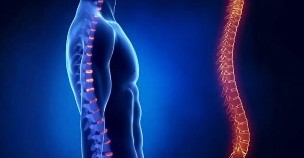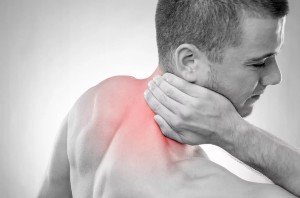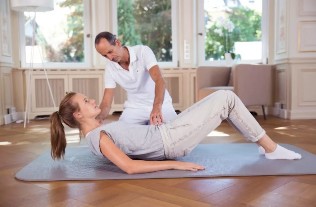Osteocondrose degenerative defeats the cartilages of the joints, and they are the best in the underneath of the tissues of the bone. The disease affects all the joints of the musculoskeletal system. The national medical osteochondrosis so-called complex and the degenerative processes in the intervertebral discs and small joints of the spine and vertebrae.

What is the osteocondrose?
Osteocondrose of the spinal column, is a collar, the new-born, and lower back. The type of the disease, the particular location of the modified fabrics. On the basis of the disease is a violation of trophic, the intervertebral discs and the vertebral bones. It causes a paradigm shift in the structure of the articular cartilage. Because of the dystrophy of the cartilage of the disc loses its elasticity and changes the texture and the shape. To decrease the difference between the bone and struck it in the segment of the vertebral column loses its stability.
The reduction of the distance between the vertebrae is accompanied by all of the tension in the muscles of the back, compression of the nerve roots that leave the spinal cord. This accounts for the emergence of pain and the neurological symptoms of focal lengths when you osteocondrose.
Dystrophy, disks, leads to a weakening of its outer fibrous rings. Therefore, in patients with osteochondrosis often there is a protrusion (the protrusion part of the drive), and a spinal hernia (protrusion pulpous of the kernel from the disk into the spinal canal). In the future, the condition applies to the small facet joints of the vertebral column ligaments of the vertebral column:
- occur in proliferation, in the bone of the vertebra;
- the patient is difficult to bend, stretch;
- you lose the flexibility of the spinal column;
- they appear subluxations vertebra;
- bent is affected in the spinal column (kyphosis, scoliosis).
Degenerative changes in the articular cartilage and the bone tissue is a normal result of the aging process. For a number of reasons for the development of the disease it can speed up. Over 70% of the patients with osteochondrosis — the number of people over the age of 45. The early occurrence of a pathology related to the poor physical condition of overweight children in that age range.
The youth of a whole lot of time to spend at the computer and the tv, avoiding the furniture, games, street artists, walking, and sporting activities without even knowing what it is to osteocondrose, and how much of it is marginal at best. Spend a lot of time in the sitting position, it
- the breach of the clutch;
- the weakness of the muscles of the upper back.
- the development of back problems.

The causes of degenerative disc disease.
The cause of the disease, were divided into 3 groups. The first one is related to the increase in the load on the column:
- the excess weight of every one:
- heavy physical labor (especially on the freight elevators);
- occupations that require long period of standing or sitting;
- by wearing an uncomfortable shoes, high heels, bags on just one shoulder;
- a poor sitting posture;
- it is not enough developed, the structure of the muscles due to an inactive lifestyle;
- congenital and acquired deformity of the spinal column;
- flat feet.
To the second group belong to the internal causes:
- of the inheritance;
- the changes are related to age;
- the charges of the violation;
- the poisoning of the body.
- the stress, the stress;
- the heavy body of the disease;
- hormonal changes (eg, pregnancy, menopause);
- an autoimmune disease of the connective tissue.
The third group is made up of external factors:
- injuries to the spinal column;
- the lack of vitamins and mineral compounds (especially vitamin D, in the group A, calcium, and phosphorus);
- to the evil ones.
- dream of an uncomfortable mattress and pillow.
In professional sports it is the cause of the aging intervertebral disc 20 in the training. The process of degradation is accelerated after the abrupt cessation of exercise.
The symptoms of degenerative disc disease.
Osteocondrose a chronic disease, one that runs with alternating periods of exacerbation and remission. The development of symptoms, with acute by:
- the excess of physical stress;
- the extra work;
- forum;
- of the injury;
- the trembling of the body, and the effects of vibration.

The clinical presentation of acute exacerbation depends on the location of the dead in the cartilage, and the presence of complications.
- For degenerative disc disease cervical spine-typical of a pain in the neck, the hands, stiffness in movements, numbness in fingers, pain in the neck. If you squashed the vertebral artery, the state of man's will, you'll get your throbbing headache, nausea, dizziness, decreases, and the rumor is, having a 'front view of the front of the eye", it is possible to faint.
- The signs of degenerative disc disease of the chest: concerned about the acute or complain of lower back pain, a sense of a "stake in the chest, pain in the heart and the internal organs, shortness of breath (hard to breath in a full chest because of the muscle stiffness and soreness).
- When the lumbar spine osteocondrose occurs in the lower back pain, the sacrum, and the feet, increasing during the trip. Happen, pain in the back and lower back during exercise, numbness of lower limbs. Appear in dysfunction of the organs in urination (the pain, the violation, urinary function, problems with potency in men, and the shortcomings in the functioning of the ovaries in the female). In the period of remission, the patient feels a mild pain that only occurs while under the influence of the factors stimulating (loads are forced on the issues, attitudes and so on).
Osteocondrose and FAR
Pathology in the intervertebral joints, often leading to jamming the nerve roots, blood vessels that feed the brain, irritation, vegetative nodes, which are responsible for the functioning of the internal organs. All of these factors are the root cause of the violations of the cardiovascular and nervous systems. In 8 out of the 10 patients, osteochondrosis develops on the syndrome and peripheral dystonia, (VI), the symptoms are that they:
- a sudden change in the blood pressure;
- the pain of the head;
- nausea and vomiting;
- the sleep disorder;
- shortness of breath;
- chills or hot flashes heat
- the total decline in strength.
In severe cases, there may be loss of consciousness.
In 95% of cases, only one relationship, between the well-being of the patient and the condition of the weather.
The symptoms that accompany it, not only osteocondrose. Patients a clinical that resembles a painting in need of a medical examination, to exclude the body and the pathologies of the endocrine.
A diagnosis of degenerative disc disease.

The patient should be aware of what a doctor will cure the osteocondrose to go to the reception desk to the right specialist. Problems of the spinal column is involved in a neurologist to be called in to relieve aches and pains in your back, neck, and lower back. In the examination of patients with suspicion of osteocondrose goes through phases, and it can take anywhere from 1 to 7 days
- search
- the inspection of the outside of the spinal column in various positions of the body (lying down, sitting, standing);
- palpation of the vertebral column, located around the soft tissue;
- the definition of the range of motion in the different areas of the spinal column;
- background research paper: computerized tomography, nuclear magnetic resonance, the resonance, the x-rays.
When a difficult diagnosis to become specific from the search to the blood vessels, and peripheral nerves.
What and how much explaining and talking points for the osteocondrose?
In the treatment of degenerative disc disease of the spine in a long, long, and requires a joined-up approach. The therapist will apply the interactions, and of therapy methods and suggests an individual approach to each patient. Treatment choice of the scheme depends on:
- the severity of the disease;
- the state of health of the patient.
- the presence of complications of the disease.
An important condition is that the effective treatment of degenerative disc disease – a step-by-step instructions. The main goal of the therapy is worsening of the disease, eliminating the pain. The patient is advised of the peace, as well as wearing special corsets, and collars for the purpose of discharging from the spinal cord. Applied to the interior and the outside of the drug treatment, performed the physical therapy. In the next stage, carry out the activities that they are alert for new problems:
- therapeutic exercise high-dose exercise to strengthen the muscle corset, and the development of correct posture);
- massage therapy;
- the chiropractic treatment;
- you choose, and t. d.
Medical treatment
Drug therapy when a osteocondrose aims to do away with the pain, and the regeneration of tissue and cartilage, improving the microcirculation and trophic on the part of the affected segments of the spinal cord. The patient is prescribed in order to:
- pain-killers and anti-inflammatory non-steroids (pills, shots, topical ointments, and PR.);
- relax your muscles to relieve tension in the muscles, which appears when the osteocondrose, and it causes pain.
- the place is an analgesic (painkiller), treatment with compresses and with novocaine, drugs blocking the spray adhesive, and other things.
- chondroprotectors, which can contribute to the regeneration of the cartilage;
- vitamins & minerals in the tablet or in the form of solutions for injection;
- vasodilators drugs to the correct reflektornago a spasm of the blood vessels;
- drugs for the normalization of metabolism in the body's tissues.

Therapeutic exercise
Therapeutic exercise, or therapy, for a year, when the osteocondrose contribute to the development of a strong muscular corset, which provides for an even distribution of the load on the lumbar spine. Thanks to the regular program:
- it improves the blood circulation and nutrition of tissues of the intervertebral discs;
- it is produced in a correct position;
- it increases the amount of motion in the spine.
Breathing exercises to relieve the muscle spasm and pain, and swimming, reduces traffic, and relaxes your spinal cord.
Medical gymnastics, classes for rehabilitation, simulations that are carried out after the comtihania the acute symptoms of the disease.
Basic rules of the physical practice:
- example: the exercise that I do on a daily basis);
- the gradual (the lessons last for 10 to 15 minutes each week, you will need to increase its duration to 5 minutes within the time limits of 2 months)
- the moderation after the lesson, the patient feels it is easy to fatigue, exhaustion after exercise, is a symptom of a bad approach to therapy for a year.
The exercises should not give any discomfort. When you are prompted for the pain lessons, you should stop by and talk it over with your doctor the possibility of your studies.
Helper methods for the treatment of degenerative disc disease.
Built-in conservative treatment of degenerative disc disease in addition to drug therapy, and therapy for a year, includes the following:
- massage helps to relieve muscle spasm, eliminate pain and improve the circulation of blood in the tissues;
- manual of therapy;
- physical therapy: whirlpool bath, lasertA saudi arabia, magnetic therapy, sonication impact.
- vocêta the organizing Committee of the vertebral column in the equipment;
- reflexology and acupuncture: the effects on the reflex-zone and the hot spot relaxes and relieves tension in the lower back pain.
In the prevention of degenerative disc disease.
When osteocondrose necessary in order to reduce the load on the column:
- wear comfortable shoes and quality;
- to avoid long-term exposure to issues with posture or in a standing position;
- keep track of the weight of the body;
- look at the posture is correct.
- don't lift weights, and then, if necessary, to uniformly engage both of your hands to distribute the weight.

It is worth to take care of the physical fitness and strengthen the muscles of the back, which helps to your daily total-strengthening of load, classes, the pool, the yoga.
A very important part in the prevention of degenerative disc disease that is your diet. You need to include in your diet:
- leitePRnodReino UNIDOts;
- the fish
- soups and stews;
- jam you can find;
- jam you can find;
- leafy vegetables;
- green;
- the olive oil and the butter;
- eggs.
Soft drinks, alcohol, coffee, strong meat and fat and salt to be dispensed.
In general, to diagnose, osteocondrose it is not so simple: it is not independent of the symptoms, it is often the x-rays detect problems in the spinal column of the spine in people who have never experienced it in the course of times of lower back pain. The first bell for a time to see your doctor, they can be a pain in the head, peak pressure, body weight, muscle mass, and dizziness when turning the head. Often times, the disturbances of the posture of the reflected and the appearance of the shape: comytUlay the back, and a distinctive hump, which is strongly curved towards the back and your stomach tight.
































